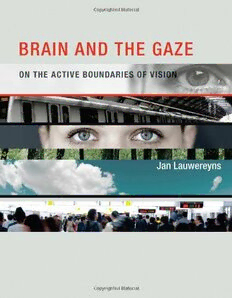Table Of ContentBrain and the Gaze
Brain and the Gaze
On the Active Boundaries of Vision
Jan Lauwereyns
The MIT Press
Cambridge, Massachusetts
London, England
© 2012 Massachusetts Institute of Technology
All rights reserved. No part of this book may be reproduced in any form by any electronic
or mechanical means (including photocopying, recording, or information storage and
retrieval) without permission in writing from the publisher.
MIT Press books may be purchased at special quantity discounts for business or sales
promotional use. For information, please email [email protected] or write to
Special Sales Department, The MIT Press, 55 Hayward Street, Cambridge, MA 02142.
This book was set in Syntax and Times Roman by Toppan Best-set Premedia Limited,
Hong Kong. Printed and bound in the United States of America.
Library of Congress Cataloging-in-Publication Data
Lauwereyns, Jan, 1969 –
Brain and the gaze : on the active boundaries of vision / Jan Lauwereyns.
p. cm.
Includes bibliographical references and index.
ISBN 978-0-262-01791-6 (hardcover : alk. paper)
1. Vision — Popular works. I. Title.
QP475.5.L38 2012
612.8'4 — dc23
2012004935
10 9 8 7 6 5 4 3 2 1
Contents
Prelude: Output for Input ix
This Inspired and Careless Decision x
My Promises xii
Looking Forward to the Past xv
Laboratory of Sensorimotor Research xix
1 Free Viewing 1
The Dynamics of Gaze 2
Covert versus Overt Processing 7
Biased Viewing 14
Informativeness 19
The Intrinsic Attraction of News 22
Perception for Perception 27
Sting, Speck, Cut, Little Hole 32
2 A Sensorimotor System 39
Oculomotor Control 43
Architecture of Exchange 49
What versus Where (or How) 54
Truly Embodied Mapping 58
The Context as a Cue 62
Integration across Views 67
Virtual Content 69
3 The Moving Retina 77
Absurd in the Highest Degree 78
What Is an Apparatus? 81
Change Vision versus Cluelessness 89
vi Contents
Functional Promiscuity 94
Retina 2.2 98
The Orienting Response 104
On the Shaping of Reception 107
4 Seeing and Grasping 111
The Poetics of Space 112
The Parallax View 119
Transmitted to the Internal Sense 122
Predictive Remapping 129
Dynamic Sensitivity 133
The Self in the World 139
The Costs and Benefits of Affordances 141
5 The Intensive Approach 149
I Presuppose Therefore 151
Entering the Inner Chamber 156
Echo Variations 161
Filling In 166
Magnitude and Duration 170
Critique of Pure Vision 175
True Colors 180
6 The Gaze of Others 185
Emission 187
Choice by Association 189
Gaze Following 194
Mirror Neurons 198
Window to the Theory of Mind 203
Gaze as a Love Object 209
Optimally Interacting 215
7 Seeing and Nothingness 219
The Horopter 220
Powers of Presence 224
Blindness 230
Taboo 236
Vanishing Point 240
Truths of Stone 244
Consciousness, the Space of Literature 248
vii Contents
Coda: Esemplastic Power 251
Nature Has No Such Thing 252
Dynamically Coupled with the World 255
The Gravity of Harmony, Once More 256
Lying in a Hammock 258
Bibliography 259
Index 281
Prelude: Output for Input
How do we gain access to things as they are? The question requires no
defense — it is about as basic and important as it gets. How can we tell
what is true from what is false? How does perception work? Questions
such as these arise naturally, frequently, with slight variations, at different
times and in different circumstances, in the minds of mothers, children,
judges, journalists, scientists, artists, philosophers, police officers, politi-
cians, bankers, insurance agents, managers, and most other human beings.
In my head, these questions also resonate with the voices of thinkers and
poets like William James (1890|1950b) and Wallace Stevens (1951). Says
William James in volume 2 of his P rinciples of Psychology , at the begin-
ning of chapter XXI on “ The Perception of Reality ” (1890|1950b, p. 283):
Everyone knows the difference between imagining a thing and believing in its
existence, between supposing a proposition and acquiescing in its truth. In the
case of acquiescence or belief, the object is not only apprehended by the mind,
but it is held to have reality. Belief is thus the mental state or function of cogniz-
ing reality. As used in the following pages, “ Belief ” will mean every degree of
assurance, including the highest possible certainty and conviction.
Everyone has experienced the difference between truly perceiving an
object and merely imagining it. But do we know the difference? When
and how can we be certain that we are “ cognizing reality ” ? Gigerenzer
(2002) assures us that in this life nothing is certain but death and taxes.
Even William James appears to start stuttering in the quoted passage,
struggling with a peculiar definition of “ belief. ” The definition is valid
only within the context of his text ( “ the following pages ” ), James implies.
Outside it, the tricky word “ belief ” may often be associated with convic-
tion, but not necessarily as a function of reality. In The Necessary Angel:
Essays on Reality and the Imagination , Wallace Stevens (1951, p. 33)
offers a suggestion I would like to read as a reply to James:

